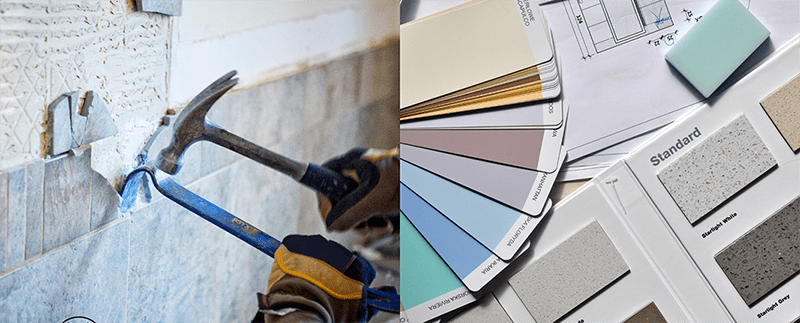Are you looking to refresh your home, but you aren’t sure where to start or who to hire? When it comes to enhancing the aesthetics and functionality of your home, two terms often come up: renovation and interior design. While they may seem interchangeable to some, they are distinct concepts in the world of home improvement. This article aims to shed light on these differences and help you understand how they both play vital roles in interior design remodeling.
What is Renovation?
Renovation refers to the process of repairing or updating an existing structure to improve its condition or functionality. It can involve tasks like repainting walls, replacing old plumbing or electrical systems, installing new flooring, or even knocking down walls to create more space. The primary goal of renovation is to restore or enhance the structural integrity and utility of a space.
In interior design remodeling, renovation forms the backbone. It sets the stage for all subsequent design work by ensuring that the basic elements of your home are in good shape. For instance, there’s no point investing in high-end furniture if your roof is leaking, or your walls have structural issues.
What is Interior Design?
Interior design, on the other hand, focuses on creating aesthetically pleasing and functional spaces within a structure. It involves selecting color schemes, choosing furniture and fixtures, arranging layouts, and incorporating decorative elements that reflect a homeowner’s personal style and needs.
In essence, interior design breathes life into a renovated space. It transforms an empty shell into a comfortable living area that resonates with your personality while also serving its intended purpose efficiently. For example, an interior designer can turn a renovated basement into a cozy family room or an efficient home office depending on your requirements.
The Role of Interior Design Remodeling
Interior design remodeling combines elements of both renovation and interior design to create spaces that are not only structurally sound but also aesthetically appealing and functional. This process begins with assessing the current state of your home, identifying areas that need repair or updating, and then planning the design elements that will enhance the space.
The remodeling process can be as simple as giving a room a fresh coat of paint and rearranging furniture, or as complex as completely gutting a space and starting from scratch. Regardless of the scope, interior design remodeling aims to create spaces that reflect your style and meet your needs while also adding value to your home.
Understanding the Interplay between Renovation and Interior Design
While renovation and interior design are distinct processes, they are closely intertwined in interior design remodeling. Renovation lays the groundwork for interior design by ensuring that the structure is sound and functional. Once this foundation is established, interior design steps in to enhance the aesthetics and functionality of the space.
For instance, if you’re remodeling your kitchen, you might start by renovating outdated elements like old cabinets or worn-out countertops. Once these structural issues are addressed, an interior designer would step in to select new cabinetry styles, countertop materials, color schemes, lighting fixtures, and other design elements that transform your kitchen into a stylish and efficient cooking space.
Overall, while renovation and interior design may seem similar on the surface, they serve different yet complementary roles in home improvement. Understanding these differences can help homeowners make informed decisions when undertaking an interior design remodeling project.
If you need help combining sound renovation practices with thoughtful interior design strategies, we can help you create spaces that are not only structurally sound but also beautifully designed to reflect your personal style and meet your needs. Reach out to Reimagine Renovation today to set up a discovery call!

